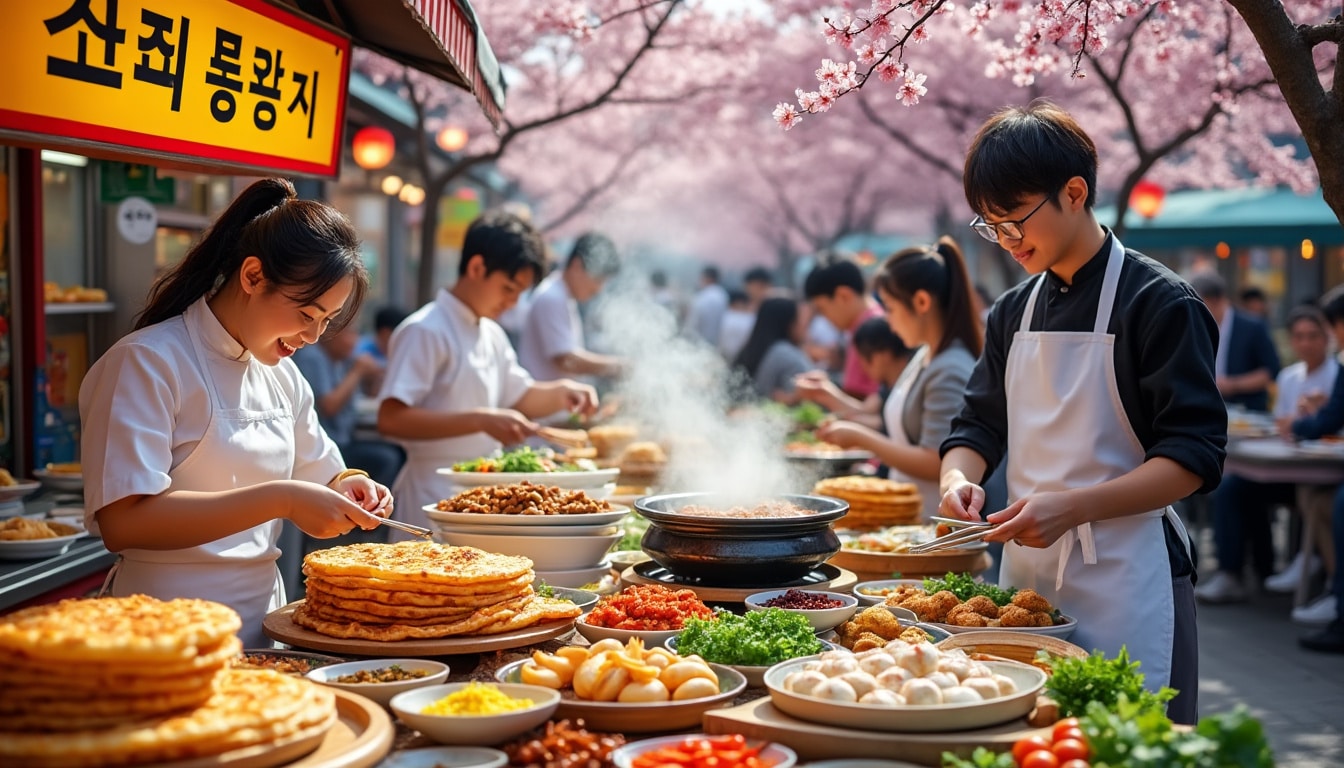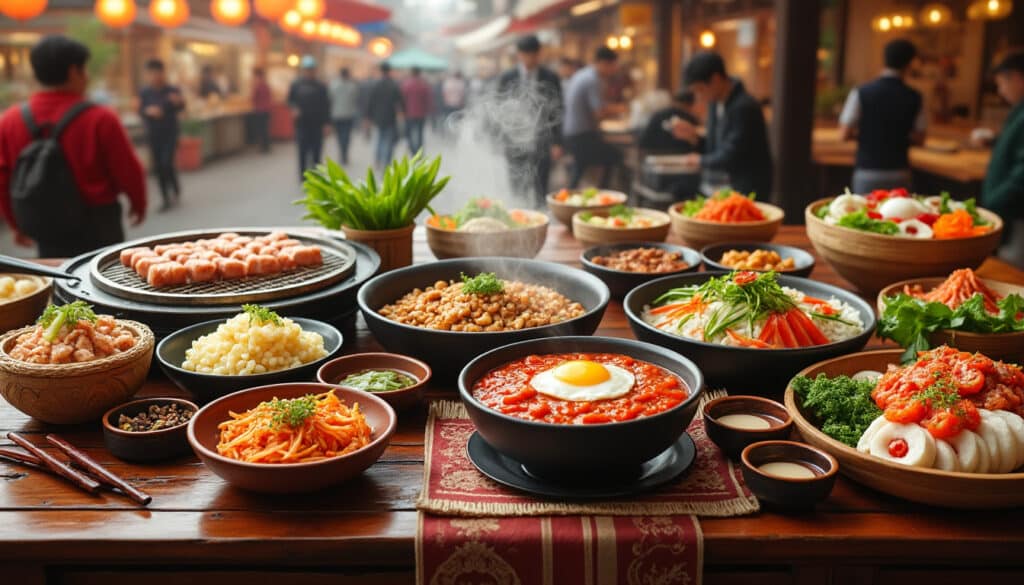Seoul, the bustling heart of South Korea, is a city where culinary traditions are cherished and celebrated. From sizzling street food to meticulously prepared traditional dishes, the flavors of Seoul offer a diverse and unforgettable experience. Whether you’re wandering down alleyways laced with food stalls or dining in a sophisticated restaurant, each culinary opportunity provides a peek into the rich tapestry of Korean culture. This guide delves deep into the vibrant and flavorful world of Seoul’s cuisine, ensuring that visitors and locals alike can savor the essence of this dynamic city.
Exploring Seoul’s Iconic Street Foods
Seoul’s street food scene is nothing short of legendary. The vibrant stalls lining Myeongdong Street and Gwangjang Market offer a smorgasbord of flavors that entice both the palate and the senses. From the sizzle of Korean Fried Chicken to the steam rising off Tteokbokki, every corner of these bustling markets tells a story through food.
Tteokbokki, a popular snack made of chewy rice cakes bathed in a spicy gochujang sauce, is a staple found nearly everywhere, providing warmth during cooler months. Visitors might also indulge in the sweet and spicy flavors of Hotteok, a pancake filled with sugar, nuts, and cinnamon, especially favored in winter 😊.
Meanwhile, freshly fried Korean Fried Chicken, typically served with a cold beverage, is a testament to Seoul’s ability to beautifully blend texture and taste. Its crispy exterior complements the juicy, flavorful meat within.
These street foods aren’t just snacks; they’re cultural icons. Every bite offers a taste of Seoul’s history and innovation, illustrating why these dishes remain so beloved. For those visiting, a stroll through these vibrant markets offers an unparalleled glimpse into the heart of Korean culinary culture.
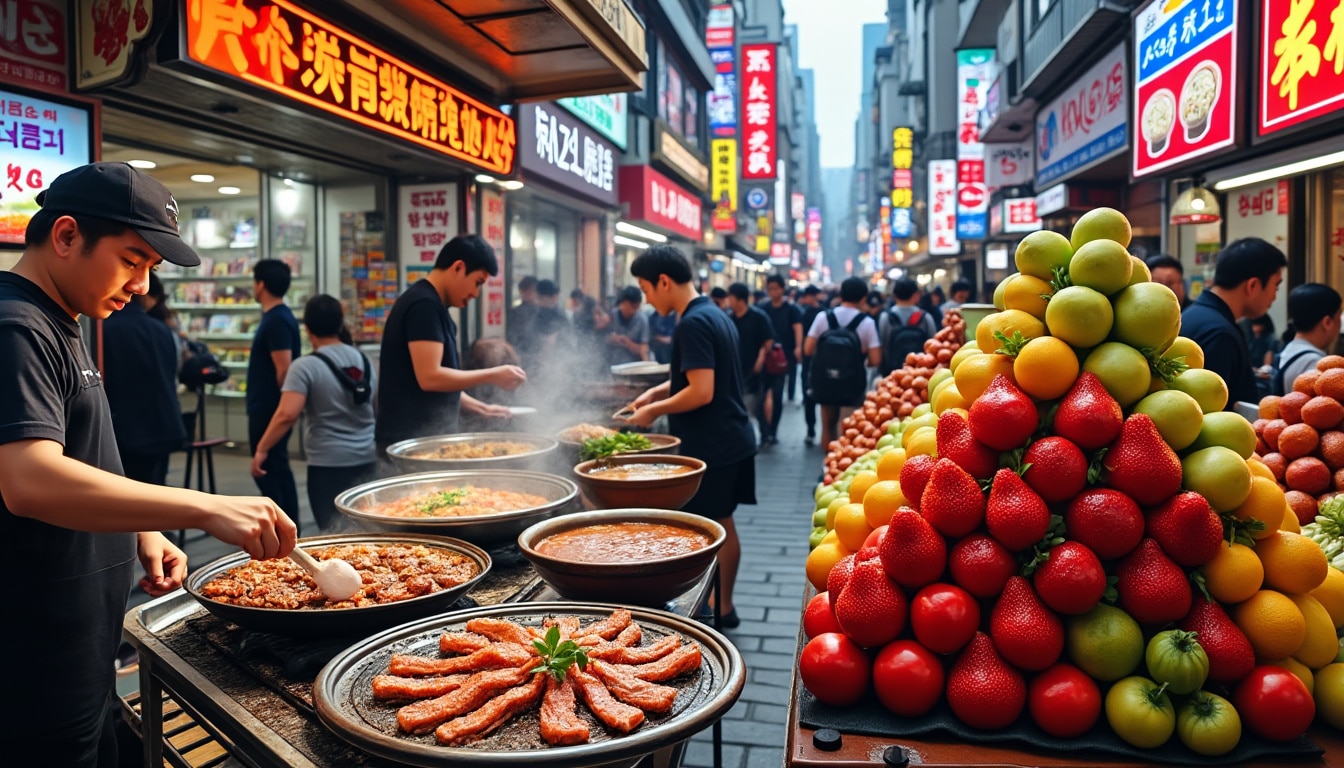
Lists of Must-Try Street Foods in Seoul
- 🌶️ Tteokbokki – Spicy Rice Cakes
- 🍗 Korean Fried Chicken
- 🥞 Hotteok – Sweet Pancakes
- 🍢 Eomuk – Fish Cake Skewers
- 🦑 Grilled Squid
The Art of Korean Barbecue in Seoul
The experience of Korean Barbecue (KBBQ) in Seoul is more than just dining; it’s a vibrant social ritual. Renowned for its interactive and communal style, KBBQ allows diners to grill their meat right at the table, making each meal not only about taste but also about experience.
Samgyeopsal, or grilled pork belly, is often the star of these gatherings. Traditionally, the pork is wrapped in a crisp leaf of lettuce or perilla with garlic, green chili, and ssamjang – a savory, slightly spicy dipping sauce. This practice of wrapping, or ‘ssam,’ adds freshness and a variety of textures to the meal.
Some restaurants in Seoul elevate this experience by offering unique flavors of Samgyeopsal, such as wine, herb, and even curry-infused options. Notably, establishments like Old House Charcoal Meat Restaurant in Hongdae are famous for their high-quality meats and extensive operating hours, allowing for late-night feasting on perfectly grilled delicacies 🍖.
| Popular KBBQ Meats | Flavors |
|---|---|
| Pork Belly (Samgyeopsal) | Original, Wine, Herb |
| Beef Ribs (Galbi) | Traditional, Soy-garlic |
| Chicken | Spicy, Teriyaki |
Beyond the food, the ambiance of KBBQ spots enhances the dining experience. The sounds of sizzling meat, the sight of smoke swirling from the grills, and the warm, communal atmosphere draw people in. Thus, enjoying KBBQ in Seoul is an experience that encapsulates the essence of Korean dining culture.
Traditional Korean Dishes and Their Cultural Significance
Seoul, a city steeped in tradition, offers a plethora of dishes deeply rooted in Korea’s cultural heritage. The concept of Banchan perfectly illustrates this. These small side dishes, including Kimchi, are integral to Korean meals, adding a spectrum of flavors and textures that transform a simple meal into a lavish feast.
Kimchi, the iconic fermented dish of spicy, tangy goodness, is considered the heart of Korean cuisine. Whether served as a standalone dish or incorporated into staples like Kimchi fried rice, its presence is ubiquitous.
Another traditional favorite is Bibimbap. This dish, meaning “mixed rice,” combines rice with assorted vegetables, egg, and gochujang, embodying the balance and harmony of Korean flavors. At establishments like Myeongdongjeong, diners can indulge in Bibimbap while wearing traditional hanbok, merging culinary and cultural heritage.
Key Features of Seoul’s Traditional Dishes
- 🌶️ Kimchi – Fermented Vegetables
- 🍚 Bibimbap – Mixed Rice Bowl
- 🥚 Gyeran Jjim – Steamed Egg
- 🍶 Doenjang Jjigae – Soybean Paste Stew
- 🐟 Godeungeo Gui – Grilled Mackerel
These traditional dishes are not just about consumption but connection – embedding food at the heart of celebrations, daily life, and national identity. They embody the country’s rich past and evolving present, ensuring that every meal is not just nourishing but also part of a larger cultural narrative.
The Evolution of Modern Korean Cuisine
Seoul’s culinary scene is not just about tradition; it’s also about innovation. Over recent years, fusion dishes combining Korean and global flavors have emerged, reflecting the city’s dynamic spirit and international outlook.
Restaurants are increasingly offering creative renditions of traditional dishes. For instance, Sundae, a Korean blood sausage, comes filled not just with pig’s blood but innovative ingredients like glass noodles and vegetables, catering to modern palates.
Furthermore, cafes such as Sulbing offer Bingsu, a Korean dessert revolutionized with flavors like matcha and cheesecake, blending traditional and modern sweet elements.
| Fusion Innovations | Description |
|---|---|
| Sundae Variations | Blood Sausage with Modern Twists |
| Bingsu Flavors | Matcha, Cheesecake |
| Kimchi Tacos | Korean-Mexican Fusion |
Despite these innovations, the essence of Korean cuisine remains strong, characterized by its commitment to bold flavors and communal dining experiences. Eating in Seoul offers a unique journey from the old to the new, encapsulating the exploration of a rich cultural heritage intersecting with a modern twist.
Seoul’s Must-Visit Food Destinations
To truly immerse oneself in Seoul’s culinary scene, exploring its renowned food destinations is imperative. Spots like Gwangjang Market provide an authentic taste of traditional Korean foods, offering everything from Bindaetteok (mung bean pancakes) to various types of banchan.
Meanwhile, the bustling streets of Myeongdong Street echo with the calls of vendors selling an array of street food delights. From sweetened potato spirals to savory seafood pancakes, the options are endless and the experience unforgettable 🔥.
For those seeking an upscale culinary experience, districts like Gangnam offer an array of high-end restaurants presenting traditional Korean dishes with a modern twist. Here, patrons can enjoy tasting menus that highlight the depth and complexity of Korean flavors.
Essential Food Stops in Seoul
- 🏢 Gwangjang Market – Traditional Foods
- 🚶♂️ Myeongdong Street – Street Foods
- 💡 Gangnam District – Modern Culinary Spots
- 🍲 Noryangjin Fish Market – Fresh Seafood
Seoul’s food destinations are as varied as the city itself, offering a delicious journey that is both rich in tradition and ripe with innovation. From traditional markets to modern dining hubs, Seoul promises a gastronomic adventure that appeals to every kind of food lover.
FAQ
- Is Seoul’s street food safe to eat? 🌟
Yes, Seoul is known for its clean and safe street food vendors. It’s a beloved part of the dining culture. - What is the best time to explore Seoul’s street markets? 🕒
Markets like Gwangjang are best explored in the late afternoon or early evening when most vendors are open and serving fresh food. - Are there vegetarian options in Seoul’s traditional cuisine? 🥗
Indeed, many dishes like Bibimbap can be found in vegetarian varieties. Additionally, several restaurants cater specifically to vegetarian diners. - How does the seasonal climate affect food offerings in Seoul? 🌦️
Seoul’s cuisine is influenced by the seasons, with heartier dishes in the cold months and lighter fare in the summer. - Can I experience Korean culture through food in Seoul? 🎎
Absolutely! Food is central to Korean culture, and dining offers an immersive cultural experience in Seoul.
To further explore Seoul’s culinary offerings, consider resources like Seoul Ambiance for insights into popular eateries and local food traditions.
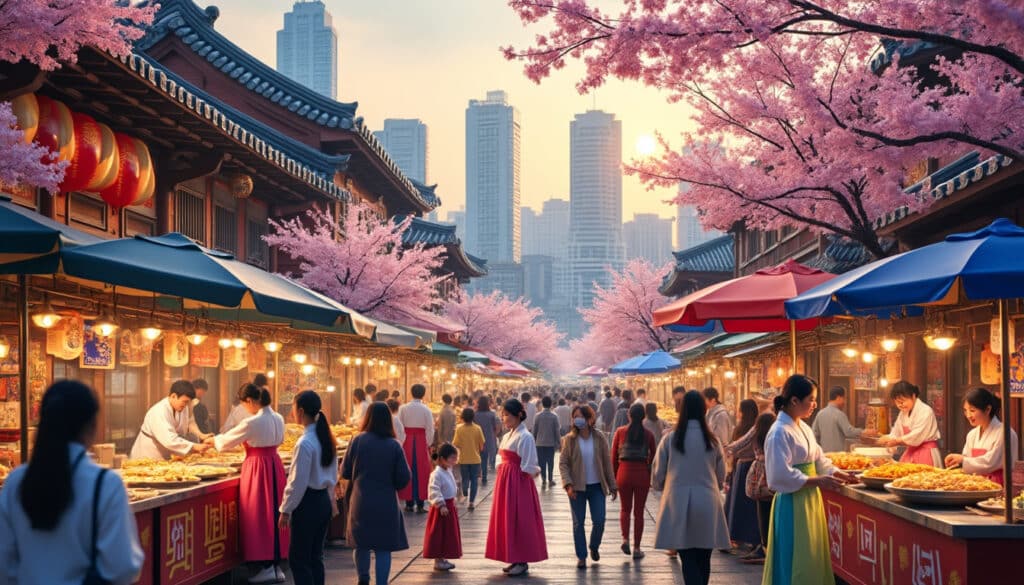
Seoul, an exhilarating blend of antiquity and innovation, is where skyscrapers and palaces coexist against the backdrop of vibrant street life. For newcomers and repeat visitors alike, the city offers a kaleidoscope of experiences that range from the rhythmic pulse…
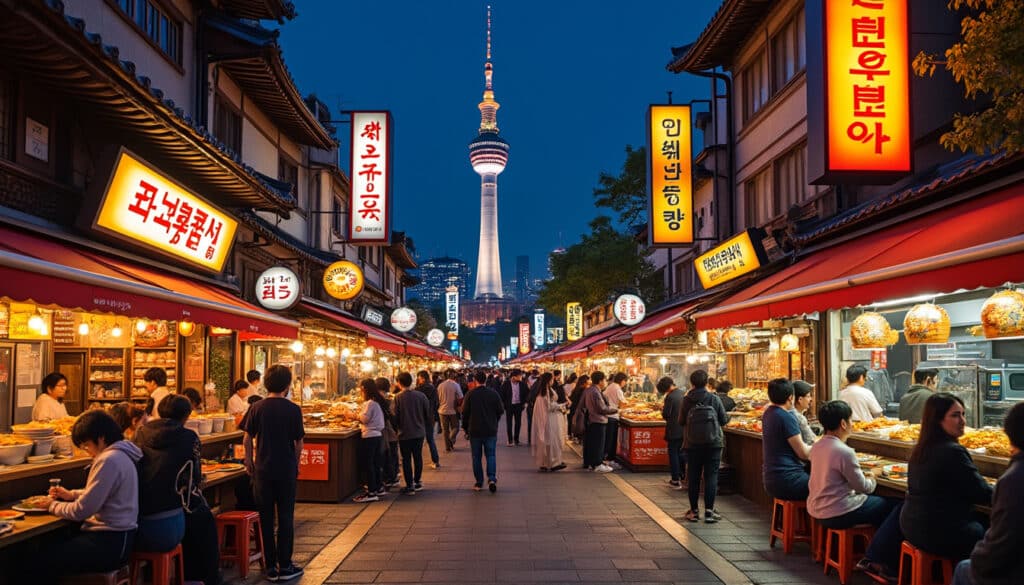
The culinary scene in Seoul is a thrilling journey that captivates both the locals and visitors yearning for genuine flavors and immersive experiences. As a city that perfectly juxtaposes tradition with avant-garde culinary innovation, Seoul boasts a vibrant food culture…
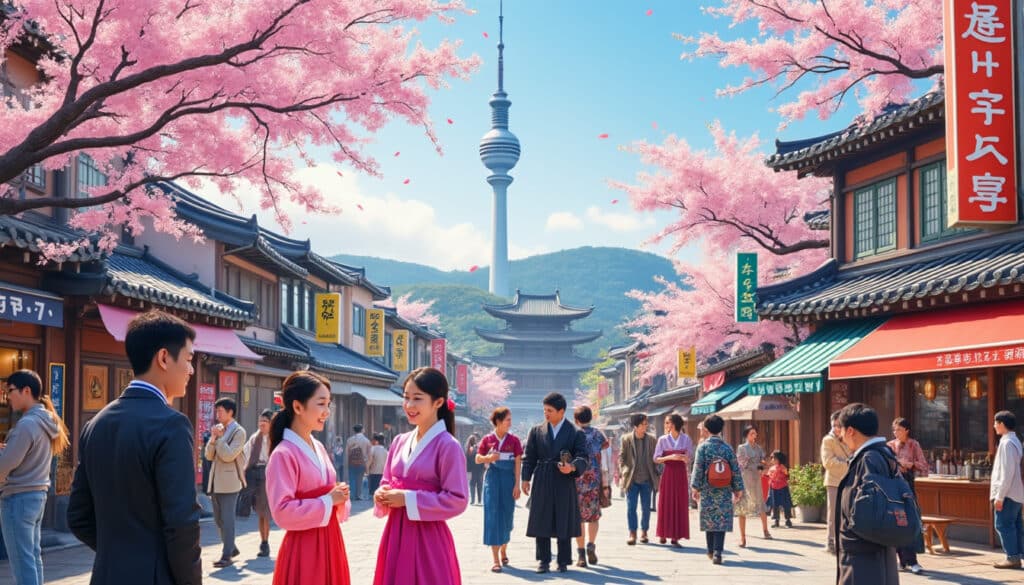
Seoul, the bustling heart of South Korea, is a city where traditional culture meets modernity in a seamless blend. It’s a place where ancient palaces stand tall among high-tech skyscrapers. More than just a geographical focal point, Seoul is a…
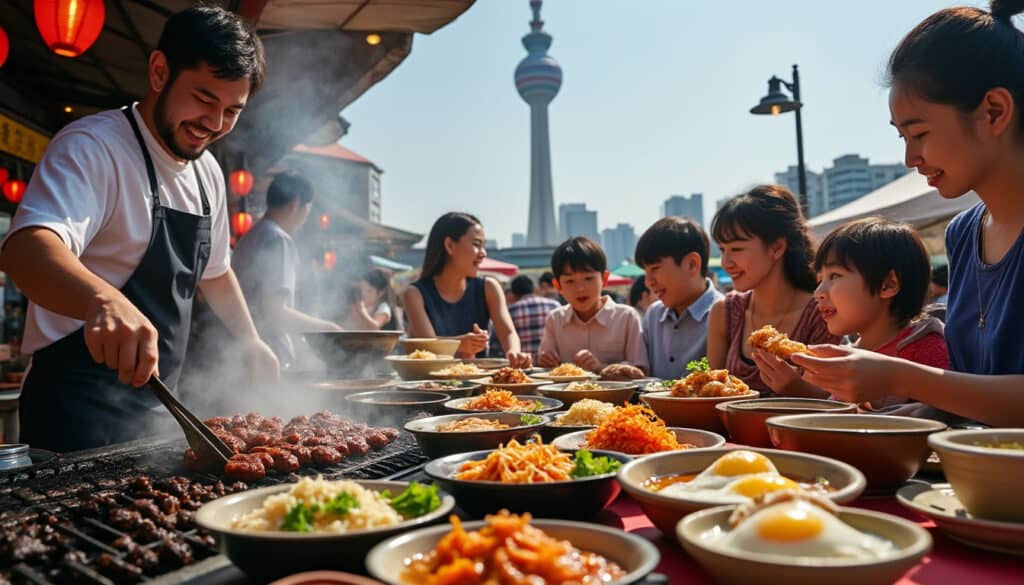
Seoul, a bustling metropolis of culture and gastronomy, offers a captivating glimpse into the culinary heartbeat of South Korea. Meal times here aren’t just about eating; they represent a deep-seated cultural practice, emphasizing family, tradition, and community. As visitors delve…
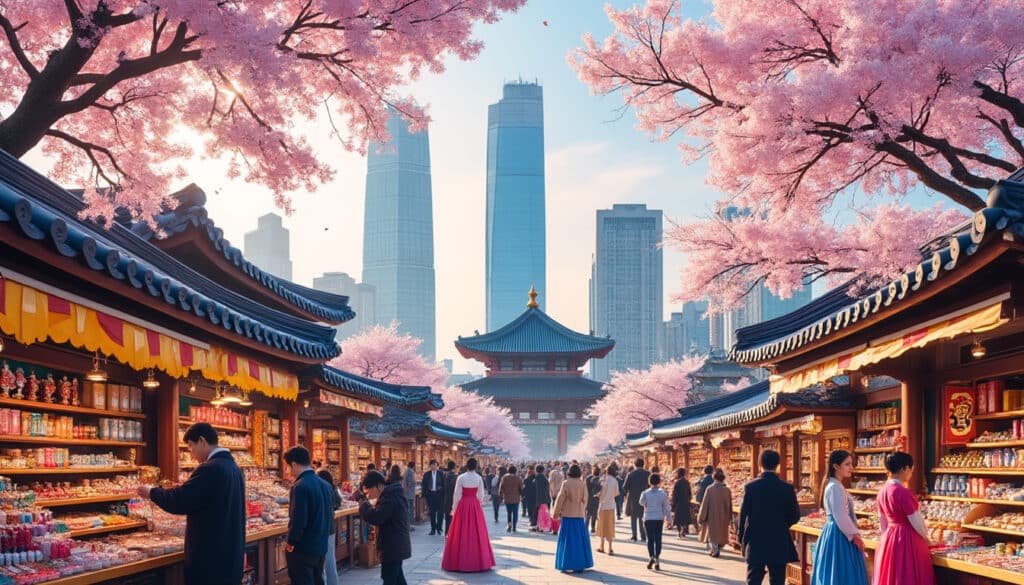
Souvenirs and shopping in Seoul
Seoul, a city where tradition melds seamlessly with modernity, offers a shopping experience like no other. This vibrant metropolis teems with life, culture, and an abundance of unique products that cater to the tastes of both its residents and its…

